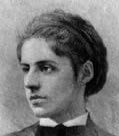
EMMA LAZARUS
1849-1887
Emma Lazarus was born in 1849 to Moses Lazarus and Esther Cardozo, Portuguese Sephardic Jews. She was the 4th child in a wealthy family of seven children and they lived around Union Square in New York City. Her uncle was the famous Supreme Court Justice, Benjamin Cardozo and her sister Josephine was also a well known author. The Lazarus family traced their ancestry back to America’s first Jewish settlers and as descendents of this pioneering group of Sephardim, they belonged to a distinct Jewish upper class. Emma inherited a rich pride in her Sephardic heritage and often wrote about the medieval scholars and poets of her ancestor’s land.
Religiously non observant, Moses Lazarus, a prosperous sugar refiner, integrated his family into Christian society. Together with the Vanderbilt’s and Astors, he founded the elite Knickerbocker Club and also built a summer ‘cottage’ in Newport, Rhode Island. But Emma was aware of the antisemitic prejudice that lurked beneath the surface of New York’s wealthy society. Despite her father’s efforts she was seen as “a Jewess” by her Christian friends. She wrote in one letter, “I am perfectly conscious that this contempt and hatred underlies the general tone of the community against us”.
In 1868, the young and precocious Emma Lazarus, who had begun to write, sent Ralph Waldo Emerson a copy of her first book. He was to become a trusted mentor and admirer of her writings.
She wrote many books of poetry, a novel on Goethe, over fifty poems published in periodicals, and an acclaimed translation of the Jewish German poet Henrich Heine. She was inspired by Heine – he was also Jewish and like her felt the pressure of different worlds on his art. She too moved between celebrating Greek myths like Admetus and legendary Hebrew scholars like Rashi. She believed in both the ideals of art for art’s sake and poetry that called for social justice.
She was also deeply affected by the wave of antisemitism and pogroms that swept Eastern Europe in the 1880’s sparking mass Jewish migration to America. Moved by the inequity of conditions in Eastern Europe, Emma Lazarus wrote some of her most powerful works. Among them was her sonnet “The New Colossus” which was written in 1883 for an art auction to raise funds for the pedestal for the Statue of Liberty.
In 1903, 16 years after her death, Emma Lazarus’ sonnet, “The New Colossus” was engraved on a plaque and placed on the pedestal as a memorial. The famous sonnet echoes many of the conflicting identities and ideals that Lazarus dealt with in her own life.